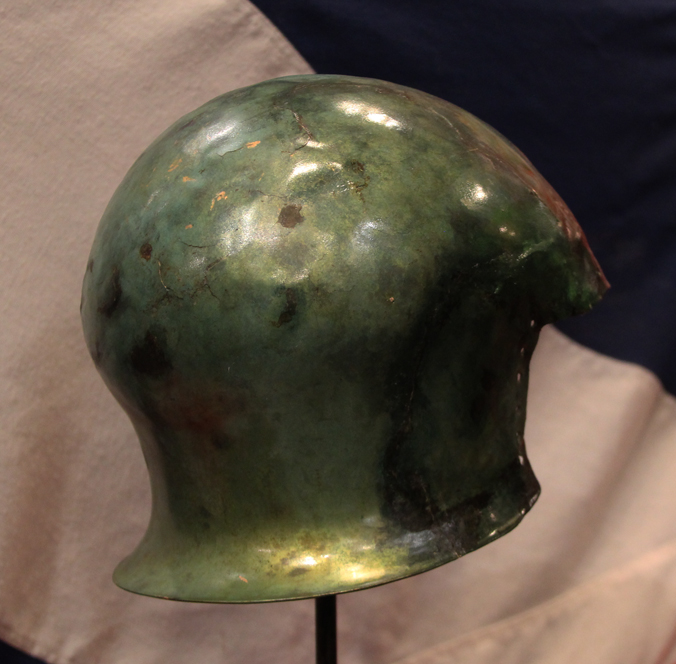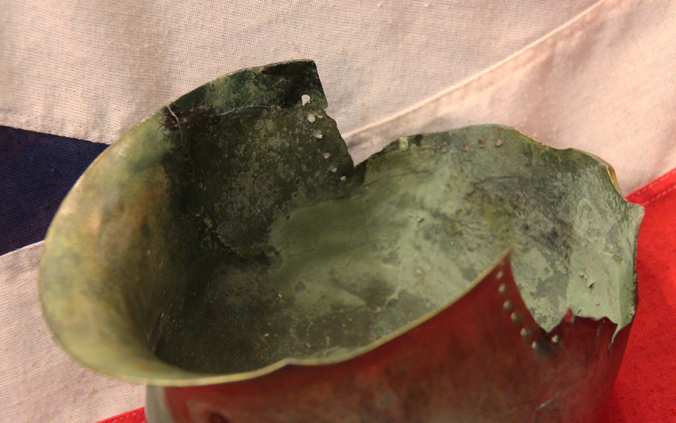Stunningly Beautiful, Museum Piece. Original Scythian Warrior's Helmet. Made & Used From the 6th Century BC, to The Battles Against Alexander the Great, Until the 3rd Century AD, The Scythian Women Warriors Are Believed To Be The Original Amazons
A bronze 'Illyrian' variant helmet, used by the so called 'barbarian' warriors, both men and women, that Herodotus classed as Amazons, that fought Darius The Great of Persia in 512bc, Alexander the Great of Macedon in 329bc, and both the Legions of the Roman Republic, and later, the Legions of the Roman Empire.
With a traditional domed skull and carination to the rear, a row of perforations to the rim around the face, and a flared neck-guard; Weight 396 grams, 26cm (10 1/4"). Fine condition, some overall aged restoration.
From the realm of the ancient Scythian warriors of ancient history that uniquely fought alongside their female warriors. The Scythian women were as famous as warriors, in fact as much as we’re the Scythian men, it is said the legend of the Amazonian warriors is entirely based on the Scythian women warriors. Herodotus provides the first detailed description of the Scythians. He classes the Cimmerians as a distinct autochthonous tribe, expelled by the Scythians from the northern Black Sea coast. Herodotus also states that the Scythians consisted of the Auchatae, Catiaroi, Traspians, and Paralatae or "Royal Scythians".
For Herodotus, the Scythians were outlandish barbarians living north of the Black Sea. In 512 BC, when King Darius the Great of Persia attacked the Scythians, he allegedly penetrated into their land after crossing the Danube. Herodotus relates that the nomadic Scythians frustrated the Persian army by letting it march through the entire country without an engagement In 329 BC Philip's son, Alexander the Great, came into conflict with the Scythians at the Battle of Jaxartes. A Scythian army sought to take revenge against the Macedonians for the death of Ateas, as they pushed the borders of their empire north and east, and to take advantage of a revolt by the local Sogdian satrap. However, the Scythian army was defeated by Alexander at the Battle of Jaxartes. Alexander did not intend to subdue the nomads: he wanted to go to the south, where a far more serious crisis demanded his attention. He could do so now without loss of face; and in order to make the outcome acceptable to the Saccae, he released the Scythian prisoners of war without ransom in order to broker a peace agreement. This policy was successful, and the Scythians no longer harassed Alexander's empire.
Although the classical Scythians may have largely disappeared by the 1st century BC, Eastern Romans continued to speak conventionally of "Scythians" to designate Germanic tribes and confederations or mounted Eurasian nomadic barbarians in general: in AD 448 two mounted "Scythians" led the emissary Priscus to Attila's encampment in Pannonia. The Byzantines in this case carefully distinguished the Scythians from the Goths and Huns who also followed Attila. Their women, after all, were trouser-wearing, horse-riding warriors, Amazons, according to Herodotus. In his Histories, the Amazons sleep with the Scythian men but refuse to cohabit with the existing Scythian women because they are not outdoorsy enough. The Amazons therefore set off with their Scythians to establish a new people.
The next known event from Scythian history is the campaign of Alexander the Great's general, Zopyrion, which took place in 331/30 BC and was directed against the Getae and the Scythians (Just., Epit., 12.1, 4). The Macedonian army of 30,000 men reached Olbia and laid siege to it, but was unable to take it and was completely routed by the Scythians. Zopyrion himself met his death.
One other Scythian king of the 4th century BC mentioned in the sources was Agaros, who had probably taken part in the internecine war between the sons of the Bosporan king Pairisades in 310/9 on the side of Satyros II; after his defeat, Satyros's son Pairisades sought refuge with Agaros. He was probably king of those Scythians who dwelt in the Crimean steppes immediately adjacent to the Bosporus.The helmet appears to have been made originally on the Corinthian model with close-fitting skull, lateral cheek-plates and projecting nasal. At some point in its combat history, it has been modified, while retaining the undulating brow profile. The perforated leading edge may have been for permanent attachment of an organic padded liner. Beyond the scope of inspired workmanship, by 5th century BC, many of the Scythian kings and nobles also opted for 'foreign' styled Greek helmets and greaves, possibly as a show of prosperity. Archaeological excavations that pertain to this period have unearthed over 60 fascinating specimens of Greek helmets (of Corinthian, Chalcidian, and Attic types) that were actually manufactured in mainland Greece and then shipped across the Black Sea into Scythian heartland via the wealthy Greek Bosporan colonies. The ancient scope in itself mirrored a wide-ranging trade network that not only entailed arms and military equipment but also slaves. Furthermore, the Scythians themselves exported profitable items like grain, wheat, flocks, and even cheese to Greece. From examination the front nasal section has been considerably restored. It has been sometime in the past extensively, though nicely, fully cleaned overall, during conservation a small supporting interior patch has been applied at the nasal area. Helmets from this era and region in unrestored condition are now so rare as to be almost unavailable, but if found, can be expected to be from 20,000 to 50,000 pounds today.
Every single item from The Lanes Armoury is accompanied by our unique Certificate of Authenticity. Part of our continued dedication to maintain the standards forged by us over the past 100 years of our family’s trading
Literature on this helmet type see;
Cf. Egg, M. & Waurick, G. Antike Helme, Romisch-Germanisches Zentralmuseum, Mainz, 1990, item 2 for original type.
Code: 22060
9850.00 GBP










